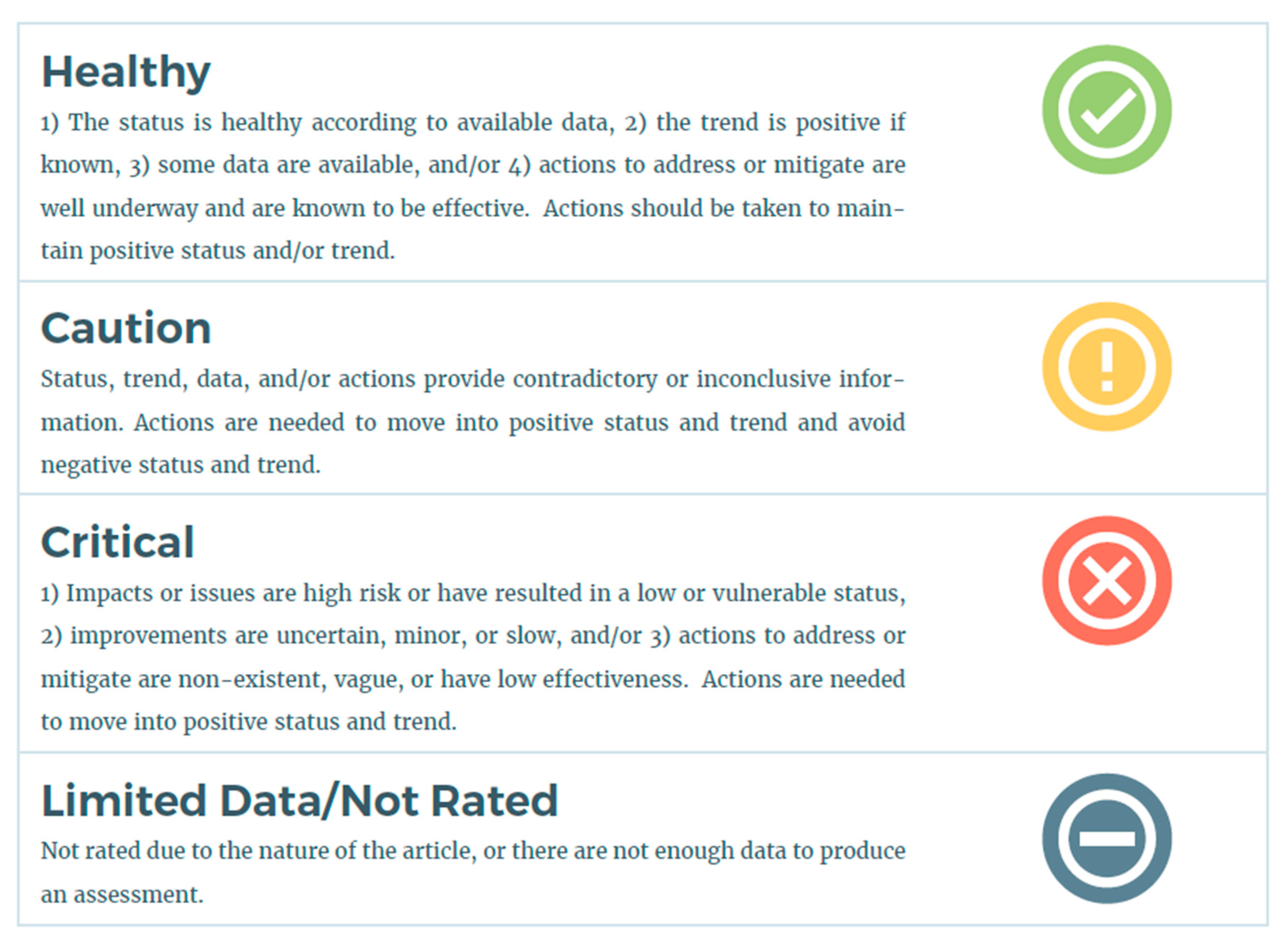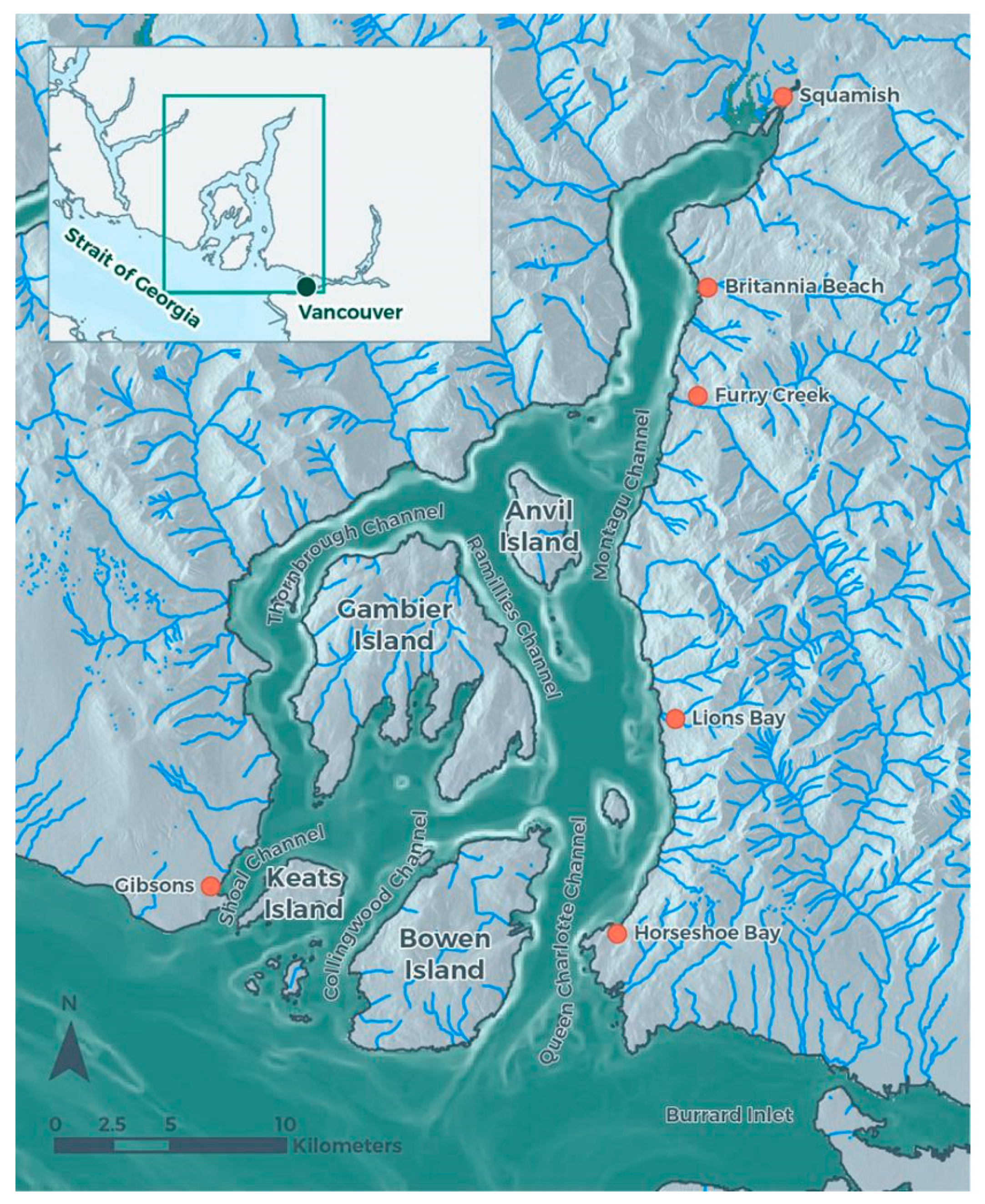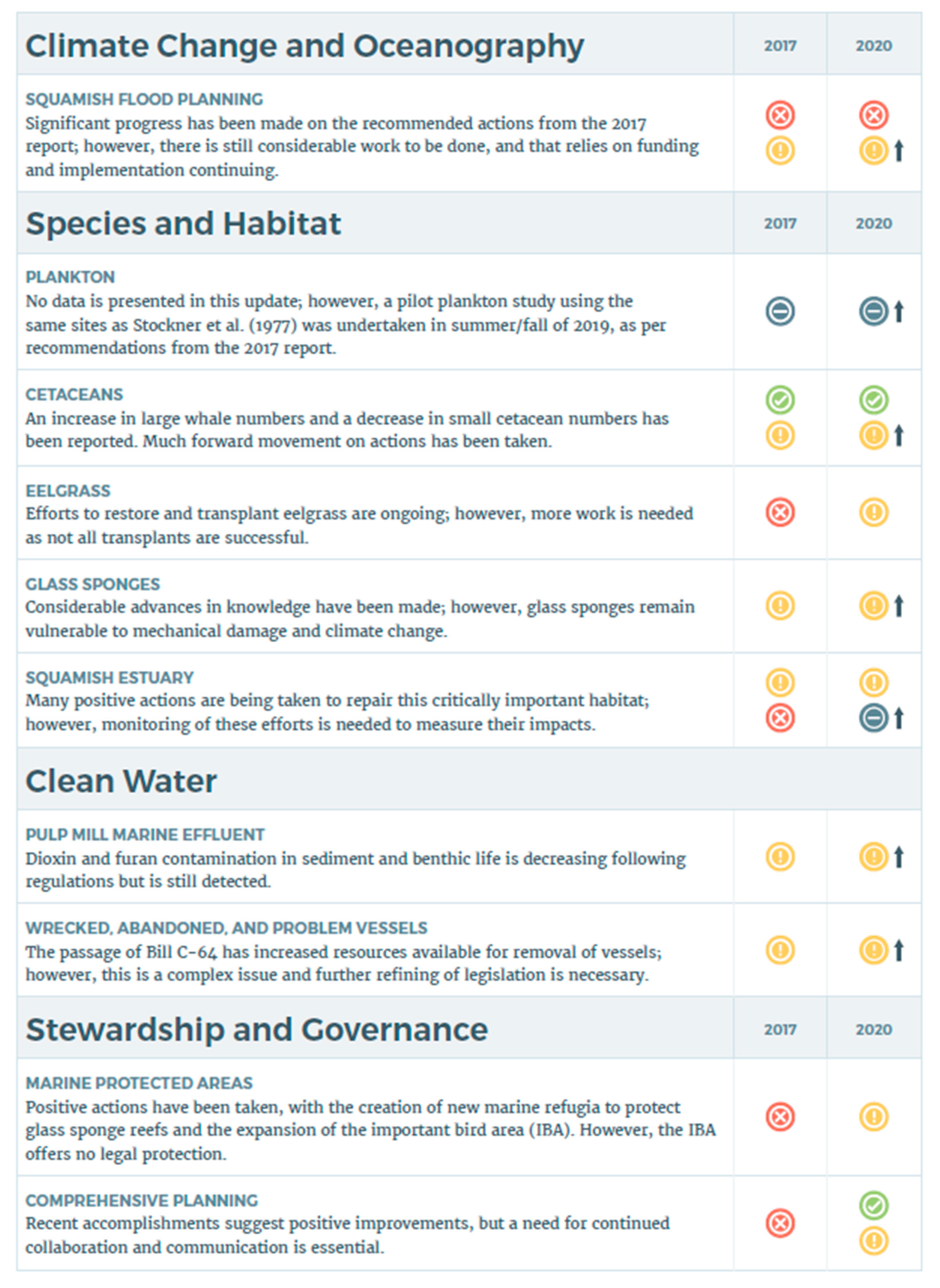Knowledge Translation Supports Community Conservation Efforts to Protect and Restore a Local Marine Environment: A Case Study of Átl’ḵa7tsem/Txwnéwu7ts/Howe Sound, British Columbia, Canada
Abstract
:1. Introduction
2. Background
2.1. Ocean Watch
2.2. Átl’ḵa7tsem/Txwnéwu7ts/Howe Sound
3. Ocean Watch Átl’ḵa7tsem/Txwnéwu7ts/Howe Sound 2020
4. Átl’ḵa7tsem/Txwnéwu7ts/Howe Sound from 2017 to 2020
5. Ocean Watch as a Tool in the Blue Economy
Supplementary Materials
Author Contributions
Funding
Acknowledgments
Conflicts of Interest
References
- United Nations. Conserve and Sustainably Use the Oceans, Seas and Marine Resources for Sustainable Development. Available online: https://sdgs.un.org/goals/goal14 (accessed on 14 July 2020).
- Pauly, D. Global fisheries: A brief review. J. Biol. Res.-Thessaloniki. 2008, 9, 3–9. [Google Scholar]
- Food and Agriculture Organization (FAO). The State of World Fisheries and Aquaculture 2018—Meeting the Sustainable Development Goals. Rome. 2018. Licence: CC BY-NC-SA 3.0 IGO. Available online: http://www.fao.org/3/i9540en/i9540en.pdf (accessed on 22 July 2020).
- IPCC. Summary for Policymakers. IPCC Special Report on the Ocean and Cryosphere in a Changing Climate. Pörtner, H.-O., Roberts, D.C., Masson-Delmotte, V., Zhai, P., Tignor, M., Poloczanska, E., Mintenbeck, K., Alegría, A., Nicolai, M., Okem, A., et al., Eds.; IPCC Spec Rep Ocean Cryosph a Chang Clim. 2019. In Press. Available online: https://www.ipcc.ch/srocc/chapter/summary-for-policymakers/ (accessed on 22 July 2020).
- Borja, A.; White, M.P.; Berdalet, E.; Bock, N.; Eatock, C.; Kristensen, P.; Leonard, A.; Leonard, J.; Pahl, S.; Parga, M.; et al. Moving Toward an Agenda on Ocean Health and Human Health in Europe. Front Mar. Sci. 2020, 7, 37. Available online: https://www.frontiersin.org/article/10.3389/fmars.2020.00037/full (accessed on 15 July 2020). [CrossRef] [Green Version]
- Rhodes, K.L.; Tupper, M.H. A preliminary market-based analysis of the Pohnpei, Micronesia, grouper (Serranidae: Epinephelinae) fishery reveals unsustainable fishing practices. Coral Reefs 2007, 26, 335–344. Available online: http://link.springer.com/10.1007/s00338-007-0202-5 (accessed on 27 July 2020). [CrossRef] [Green Version]
- Law, K.L. Plastics in the marine environment. Ann. Rev. Mar. Sci. 2017, 9, 205–229. [Google Scholar] [CrossRef] [PubMed] [Green Version]
- Duarte, C.M.; Agusti, S.; Barbier, E.; Britten, G.L.; Castilla, J.C.; Gattuso, J.-P.; Fulweiler, R.W.; Hughe, T.P.; Knowlton, N.; Lovelock, C.E.; et al. Rebuilding marine life. Nature 2020, 580, 39–51. Available online: http://www.nature.com/articles/s41586-020-2146-7 (accessed on 15 July 2020). [CrossRef] [PubMed]
- Cook, C.N.; Mascia, M.B.; Schwartz, M.W.; Possingham, H.P.; Fuller, R.A. Achieving Conservation Science that Bridges the Knowledge-Action Boundary. Conserv. Biol. 2013, 27, 669–678. Available online: http://doi.wiley.com/10.1111/cobi.12050 (accessed on 15 July 2020). [CrossRef] [PubMed] [Green Version]
- Howe Sound Biosphere Region Initiative. Howe Sound Community Forum. Available online: https://www.howesoundbri.org/hscf (accessed on 3 June 2020).
- Bodtker, K. (Ed.) Ocean Watch Howe Sound Edition; Coastal Ocean Research Institute: Vancouver, BC, Canada, 2017; Available online: https://oceanwatch.ca/howesound/wp-content/uploads/sites/2/2017/02/OceanWatchHoweSoundReport.pdf (accessed on 4 June 2020).
- Alava, J.J.; Bodtker, K. Metal contamination from the Britannia Mine site: Lingering problems, ongoing remediation. In Ocean Watch Howe Sound Ed.; Bodtker, K., Day, A., Eds.; Costal Ocean Research Institute: Vancouver, BC, Canada, 2017; Available online: https://oceanwatch.ca/howesound/wp-content/uploads/sites/2/2016/12/OceanWatch-HoweSoundReport-BritanniaMine.pdf (accessed on 10 June 2020).
- Alava, J.J. Dioxin and furan contamination from pulp mills: A successful history of source control and regulations. In Ocean Watch Howe Sound Ed.; Bodtker, K., Day, A., Eds.; Coastal Ocean Research Institute: Vancouver, BC, Canada, 2017; Available online: https://oceanwatch.ca/howesound/wp-content/uploads/sites/2/2016/12/OceanWatch-HoweSoundReport-PulpMill.pdf (accessed on 14 September 2020).
- Daneleskko, T. Once Common, then Rare: Today Cetaceans are Back. In Ocean Watch Howe Sound Ed.; Bodtker, K., Day, A., Eds.; Coastal Ocean Research Institute: Vancouver, BC, Canada, 2017; Available online: https://oceanwatch.ca/howesound/wp-content/uploads/sites/2/2016/12/OceanWatch-HoweSoundReport-Cetaceans.pdf (accessed on 10 June 2020).
- Howe Sound Biosphere Region Initiative. Ocean Watch Task Force. 2020. Available online: howesoundbri.org/howe-sound-community-forum/2020/1/9/ocean-watch-task-force (accessed on 3 June 2020).
- Miller, A.; Chapman, J.; Dearden, A.; Ross, P. (Eds.) Ocean Watch: Átl’ḵa7tsem/Txwnéwu7ts/Howe Sound Edition 2020; Ocean Wise Research Institute, Ocean Wise Conservation Association: Vancouver, BC, Canada, 2020; Available online: https://oceanwatch.ca/howesound/wp-content/uploads/sites/2/2020/08/OceanWatch-HoweSoundExecutiveSummary2020_online.pdf (accessed on 31 August 2020).
- Miller, A. Shoreline Erosion and Sea Level Rise. In Ocean Watch Átl’ḵa7tsem/Txwnéwu7ts/Howe Sound Ed. 2020; Miller, A., Chapman, J., Dearden, A., Ross, P., Eds.; Ocean Wise Research Institute: Vancouver, BC, Canada, 2020; Available online: https://oceanwatch.ca/howesound/wp-content/uploads/sites/2/2020/08/OceanWatch-HoweSoundReport2020-CC-ShorelineErosion.pdf (accessed on 31 August 2020).
- Knight, F.; Chapman, J. Stream Flows: Daisy Lake Reservoir and the Cheakamus River. In Ocean Watch Átl’ḵa7tsem/Txwnéwu7ts/Howe Sound Ed. 2020; Miller, A., Chapman, J., Dearden, A., Ross, P., Eds.; Ocean Wise Research Institute: Vancouver, BC, Canada, 2020; Available online: https://oceanwatch.ca/howesound/wp-content/uploads/sites/2/2020/08/OceanWatch-HoweSoundReport2020-CC-StreamFlows.pdf (accessed on 31 August 2020).
- Dearden, A. Marine Birds: Important Bird Area expanded into the Sound. In Ocean Watch Átl’ḵa7tsem/Txwnéwu7ts/Howe Sound Ed. 2020; Miller, A., Chapman, J., Dearden, A., Ross, P., Eds.; Ocean Wise Research Institute: Vancouver, BC, Canada, 2020; Available online: https://oceanwatch.ca/howesound/wp-content/uploads/sites/2/2020/08/OceanWatch-HoweSoundReport2020-SH-MarineBirds.pdf (accessed on 31 August 2020).
- Chapman, J. Tourism and Recreation: Opportunities and challenges. In Ocean Watch Átl’ḵa7tsem/Txwnéwu7ts/Howe Sound Ed. 2020; Miller, A., Chapman, J., Dearden, A., Ross, P., Eds.; Ocean Wise Research Institute: Vancouver, BC, Canada, 2020; Available online: https://oceanwatch.ca/howesound/wp-content/uploads/sites/2/2020/08/OceanWatch-HoweSoundReport2020-CD-Tourism.pdf (accessed on 31 August 2020).
- Dearden, A. Shrimp and Prawn Fisheries: Managing declining stocks. In Ocean Watch Átl’ḵa7tsem/Txwnéwu7ts/Howe Sound Ed. 2020; Miller, A., Chapman, J., Dearden, A., Ross, P., Eds.; Ocean Wise Research Institute: Vancouver, BC, Canada, 2020; Available online: https://oceanwatch.ca/howesound/wp-content/uploads/sites/2/2020/08/OceanWatch-HoweSoundReport2020-SF-ShrimpPrawn.pdf (accessed on 31 August 2020).
- European Commission. Final Report Summary—ARCH (Architecture and Roadmap to Manage Multiple Pressures on Lagoons). 2016. Available online: https://cordis.europa.eu/project/id/282748/reporting (accessed on 14 September 2020).
- Davoudi, S.; Zaucha, J.; Brooks, E. Evolutionary resilience and complex lagoon systems. Integr. Environ. Assess Manag. 2016, 12, 711–718. Available online: http://doi.wiley.com/10.1002/ieam.1823 (accessed on 31 August 2020). [CrossRef] [PubMed] [Green Version]
- Saxby, T.; Picketts, I.; Burhenne, L. The path to zero carbon municipalities. In Ocean Watch Átl’ḵa7tsem/Txwnéwu7ts/Howe Sound Ed. 2020; Miller, A., Chapman, J., Dearden, A., Ross, P., Eds.; Ocean Wise Research Institute: Vancouver, BC, Canada, 2020; pp. 50–74. Available online: https://oceanwatch.ca/howesound/wp-content/uploads/sites/2/2020/09/OceanWatch-HoweSoundReport2020-CC-ZeroCarbon.pdf (accessed on 31 August 2020).
- Simons, R. Comprehensive Planning: Progress continues but collaboration remains key. In Ocean Watch Átl’ḵa7tsem/Txwnéwu7ts/Howe Sound Ed. 2020; Miller, A., Chapman, J., Dearden, A., Ross, P., Eds.; Ocean Wise Research Institute: Vancouver, BC, Canada, 2020; pp. 372–378. Available online: https://oceanwatch.ca/howesound/wp-content/uploads/sites/2/2020/08/OceanWatch-HoweSoundReport2020-SG-ComprehensivePlanning.pdf (accessed on 31 August 2020).
- Ocean Watch: Howe Sound/Atl’ḵa7tsem Strategic Plan 2019–2021. Prepared by Eclipse Environmental Consulting Limited, for Ocean Wise Conservation Association. p. 22. Available online: https://assets.ctfassets.net/fsquhe7zbn68/35qzo0mjdczkcfHbZeWMTV/b80b29d633a9ae1bd5275b3acf0f82f1/OWTF-Strategic-Plan__updated_.pdf (accessed on 1 September 2020).
- Howe Sound/Atl’kitsem Marine Reference Guide. Howe Sound/Átl’ḵa7tsem Marine Reference Guide. 2018. Available online: https://howesoundguide.ca/ (accessed on 9 July 2020).



© 2020 by the authors. Licensee MDPI, Basel, Switzerland. This article is an open access article distributed under the terms and conditions of the Creative Commons Attribution (CC BY) license (http://creativecommons.org/licenses/by/4.0/).
Share and Cite
Chapman, J.; Dearden, A.; Miller, A. Knowledge Translation Supports Community Conservation Efforts to Protect and Restore a Local Marine Environment: A Case Study of Átl’ḵa7tsem/Txwnéwu7ts/Howe Sound, British Columbia, Canada. J. Mar. Sci. Eng. 2020, 8, 739. https://doi.org/10.3390/jmse8100739
Chapman J, Dearden A, Miller A. Knowledge Translation Supports Community Conservation Efforts to Protect and Restore a Local Marine Environment: A Case Study of Átl’ḵa7tsem/Txwnéwu7ts/Howe Sound, British Columbia, Canada. Journal of Marine Science and Engineering. 2020; 8(10):739. https://doi.org/10.3390/jmse8100739
Chicago/Turabian StyleChapman, Jennifer, Amber Dearden, and Aroha Miller. 2020. "Knowledge Translation Supports Community Conservation Efforts to Protect and Restore a Local Marine Environment: A Case Study of Átl’ḵa7tsem/Txwnéwu7ts/Howe Sound, British Columbia, Canada" Journal of Marine Science and Engineering 8, no. 10: 739. https://doi.org/10.3390/jmse8100739
APA StyleChapman, J., Dearden, A., & Miller, A. (2020). Knowledge Translation Supports Community Conservation Efforts to Protect and Restore a Local Marine Environment: A Case Study of Átl’ḵa7tsem/Txwnéwu7ts/Howe Sound, British Columbia, Canada. Journal of Marine Science and Engineering, 8(10), 739. https://doi.org/10.3390/jmse8100739



